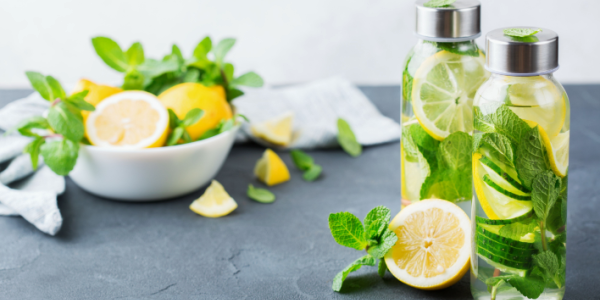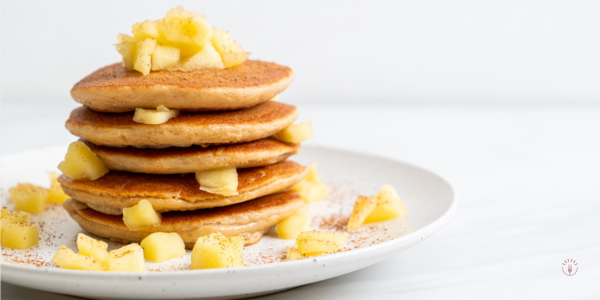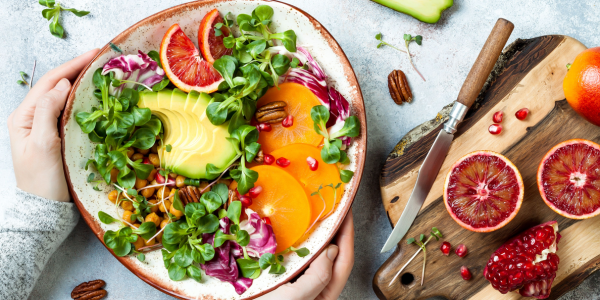
While the human body needs water to survive, meeting daily hydration requirements can be a struggle.
Not finding plain water all that appealing is normal, so why not make your H20 a little more exciting to elevate your daily intake. Healthy flavored water recipes can make all the difference when it comes to meeting hydration goals, and can take drinking water from boring to “best beverage yet!”
Join us for tips on how to make water taste better, including savory, sweet, and unexpected combinations.
The Importance of Hydration
Hydration is absolutely crucial for the body, seeing as the body is estimated to be about 60% water. From the cellular level to the outer layer of the skin, hydration is needed to maintain normal body function. An effort to stay hydrated is also linked with optimal health and other positive outcomes, such as longevity and lower disease risk.
Drinking water can even help make digestion smoother and improve the absorption of certain nutrients. Meeting your daily requirements can even help you avoid certain health problems, such as:
• Constipation
• Dehydration
• Kidney stones
• Urinary tract infection (UTIs)
Even though you may know that water is beneficial, it can feel challenging to reach the recommended amount with water alone. Fortunately, plain, unflavored water isn’t your only option for increasing hydration. Adding even just a hint of flavor can make all the difference in creating a more exciting water-based beverage.
What Impacts Water Flavor?
Many factors can impact flavor, including water quality and temperature. Understanding the influence each of these factors has on water can help you identify your favorite tastes while filtering out the troublemakers.
Water Quality
Water quality not only has implications for flavor, but also for health. Since most water in the United States comes from fresh surface water or groundwater aquifers, it’s important to understand the level of purification that happens as it travels from source to sink.
Contaminated sources can cause an imbalance of chemical composition, along with exposing the drinker to dangerous bacteria or viruses.
Luckily, there are several ways to improve water quality at home, such as the following:
• Boil water for at least one minute before drinking if it’s obtained from a source you’re unsure about or in the case of an emergency.
• Examine distribution systems within your home—such as lead or corroding copper pipes—that may cause heavy metal poisoning.
• Install a water filtration system, a reverse osmosis (RO) unit is considered one of the most effective ways to eliminate disease-causing and chemical contaminants.
Water Temperature
Interestingly, both water temperature and oral (mouth) temperature can affect how much you enjoy your water-drinking experience. Those with dental or teeth sensitivities may find drinking water that’s too cold or hot unpleasant, and that room temperature water does the trick.
Although the science isn’t quite clear on the exact reasons yet, water temperature can influence taste perception. Cold water tastes refreshing, while warm water is often considered comforting and may even soothe digestive discomfort.
Based on the current evidence, most experts suggest picking the temperature that suits your personal preference—and your taste buds!
Other Factors
A myriad of other factors can influence how your water tastes. For example, your water bottle or reusable receptacle may lend a particular flavor to your H2O thanks to the chemical makeup of the bottle itself. Sometimes, water bottles that have been sitting out or need to be washed develop a taste that can only be described as “stale.”
As mentioned above, depending on where you live, your local water source may lend its own special flavor. This is usually due to different water sources, soils, and surfaces that come in contact with water before it reaches your cup.
There’s even such a profession as a water sommelier, which is someone who can detect the subtle differences in water from around the world.
How to Make Water Taste Better
Although artificial flavorings and products with “natural flavors” are an option, these aren’t always the most prudent nutrition decisions. To offset unpleasant natural tastes or simply to enhance taste and hydration, there are plenty of healthy options to explore.
Look to Lemon
One of the most classic ways to add a bit of flavor to your H2O is a squeeze of lemon to overpower water’s natural taste. One perk of this method is that many restaurants keep lemons on hand, meaning you can request lemon slices to add to your water nearly anytime you eat out.
Lemon is also a hydration enhancer—thanks to its nutritional composition of electrolytes and minerals—that naturally helps maximize water’s benefits.
For a different approach, and one that’s especially popular in the winter, try drinking your water warm with a lemon. Many people enjoy this beverage early in the morning or at night before bed.
Enhance Hydration with Water-Rich Additions
In addition to lemon, there are many other fruits (and even some vegetables) that can add flavor to water. Actually, a few particular types of produce are natural hydration enhancers since they are mostly water by weight.
These foods include:
• Cantaloupe
• Celery
• Citrus fruits (including lemon, lime, grapefruit, or orange)
• Cucumber
• Grapes
• Pear
• Pineapple
• Strawberries
• Watermelon
Fresh fruit infuses water with its own nutrients, including many antioxidants linked to health benefits. The best part about adding these hydration (and flavor) enhancers to your drink? They won’t cause calorie counts to increase.
A quick tip: infuse water overnight to really let the flavors build!
Feature Fresh Herbs & Spices
Like adding fruit, adding certain herbs and spices to your water can provide subtle yet sensational tastes. Give the herbs a little mash if you don’t want to ingest any floating particles.
If you’re averse to herbs or spices on their own, try pairing fruits and herbs for hydration. Cucumber and fresh mint is a favorite combo, but here are a few other herb and spice combinations to try:
• Apple + cinnamon
• Lemon + ginger
• Strawberries + basil
Steep Something New
Tea bags can be enjoyed warm or chilled, and herbal teas are preferred for hydration because they usually contain herbs without caffeine. Although nutrient profiles differ from brand to brand, herbal teas are less likely to include sweeteners. It’s always a good idea to check the label for caffeine and sugar content when you’re choosing between beverages.
The blend of natural ingredients in herbal tea creates flavors so delicious that you won’t be missing anything artificial. Play around with temperatures until you find out whether hot or cold is preferred, and experiment with one or two bags to see which flavor intensity you like best.
If you’re feeling creative, you can also make your own homemade herbal tea bags!
Get Creative with Cubes
From frozen fruits and herbs to edible flower formations, ice cubes can be the most exciting part of your drink. Plus, as they melt, they can add an infusion of flavor to any beverage without diluting the drink too much.
Bisphenol A (BPA)-free ice cube trays can even be purchased at places like the Dollar Store, making ice cube experiments both fun and cost-effective.
Consider Carbonation
Another simple yet effective way to spruce water up is to make it sparkling! Does the term “sparkling water” sound more fancy? The carbonation used to create sparkling water gives the water a different texture and mouthfeel, which can take it from feeling ordinary to being extraordinary.
For store-bought carbonated waters, you’ll want to double-check the ingredients list to ensure sugar hasn’t been added. Alternatively, you can use an at-home device like the SodaStream to create sparkling water from the comfort of your kitchen.
Use to Dilute Juice
This oft-used tactic among parents of toddlers can also be utilized among adults. Diluting unsweetened 100% fruit juice is a great idea for water drinkers who want something more flavorful but aren’t fans of full-force fruit juice—some say even natural juices taste too “sugary,”
Play around with the water-to-juice ratio, and feel free to customize the blend according to the preferences of different dining companions or family members.
Give Coconut Water a Crack
Although coconut water isn’t quite the cure-all some people claim it to be, it’s still an excellent option for hydration. It’s technically a type of juice obtained from the center of a coconut but is generally counted in the water category due to its hydrating potential and clear appearance. Slightly sweet, it’s a welcome base for water-based drinks like juices and smoothies and is even enjoyed on its own.
Unflavored and unsweetened coconut water is naturally low in calories and doesn’t contain much natural sugar. A great deal of variety exists among brands, so it’s important to look at the nutrient label for a better understanding of electrolyte, vitamin, and sugar content.
Serve In a Fancy Glass or Fun-Colored Cup
It may sound silly, but serving water, sparkling water, or infused water in a fancy glass may make the whole experience more exciting!
Cups of different designs or colors are also an option. Science backs this suggestion up, too, with recent studies finding that the color of your food or beverage receptacle—like a plate or coffee mug—may influence the fullness you feel, the amount you ingest, and even how sweet a drink seems to taste.
Flavored Water Recipes
Struggling to get started? Flavored water recipes are relatively simple and great for beginners looking for a more interesting beverage. The tips and recipes below can help to spark your inspiration.
Generally, the longer you allow fruit and herbs to soak, the stronger the flavor. Most recipes recommend a minimum of infusing for two hours, with overnight refrigeration as the preferred method.
Star Fruit Infused Water
For the perfect tart-yet-sweet balance, there’s nothing better than star fruit-flavored infused water. Its star-spangled colors make it perfect for holidays and picnics, but it’s also refreshing year-round. Cut star fruit into star shapes to make the water glass more enticing.
Fruit and Herb Sparkling Water
Can’t seem to choose between all the infused water recipes? The Academy of Nutrition and Dietetics has you covered with their fresh fruit and herb sparkling water.
Drawing on the wisdom of other cultures, this drink uses multiple fruits and herbs, which may also multiply the health benefits of the beverage.
Ice Cube Ideas
Unsure of where to start when it comes to making your own ice cubes? There’s really no “right” way to create fun cubes for your beverage.
You can use everything from whole fruit—such as cherries with their stems sticking out for easy removal—to sprigs of edible herbs. Pureed fruit is also a great option to enhance water’s hydrating power.
One word of advice: be sure you understand what parts of your plant additives are edible before adding them to your ice cube tray. Not all flowers or parts of an herb are meant to be consumed. They may even cause harm during digestion, so a little research beforehand can go a long way.
How to Create a Copycat Recipe
Hesitating to give up your go-to beverage? Many recipes can be made into healthier “copycat” concoctions. In other words, it’s easy to turn your favorite drink into a healthier hydration option by slightly altering the base ingredients.
For example, create a cherry limeade-inspired drink by starting with sparkling water, infusing it with cherries and fresh lime juice, and opting for a lower glycemic sweetener like honey (or no sweetener) instead of sugar.
Making Your Water Taste Better: Final Takeaways
If plain water doesn’t sound appetizing, you aren’t alone! Beverages infused with fruit, vegetables, and herbs may make for a better hydration experience, especially when you focus on ingredients that provide potential health benefits.
Like food, it’s also helpful to look into your water’s source and decide if the way water is presented—such as in a bottle or glass, warm or cold—affects the taste. The options and combinations for healthily enhancing water are nearly endless!






